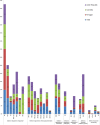Burden of lysosomal storage disorders in India: experience of 387 affected children from a single diagnostic facility
- PMID: 23852624
- PMCID: PMC3897787
- DOI: 10.1007/8904_2013_244
Burden of lysosomal storage disorders in India: experience of 387 affected children from a single diagnostic facility
Abstract
Lysosomal storage disorders (LSDs) are considered to be a rare metabolic disease for the national health forum, clinicians, and scientists. This study aimed to know the prevalence of different LSDs, their geographical variation, and burden on the society. It included 1,110 children from January 2002 to December 2012, having coarse facial features, hepatomegaly or hepatosplenomegaly, skeletal dysplasia, neuroregression, leukodystrophy, developmental delay, cerebral-cerebellar atrophy, and abnormal ophthalmic findings. All subjects were screened for I-cell disease, glycolipid storage disorders (Niemann-Pick disease A/B, Gaucher), and mucopolysaccharide disorders followed by confirmatory lysosomal enzymes study from leucocytes and/or fibroblasts. Niemann-Pick disease-C (NPC) was confirmed by fibroblasts study using filipin stain. Various storage disorders were detected in 387 children (34.8 %) with highest prevalence of glycolipid storage disorders in 48 %, followed by mucopolysaccharide disorders in 22 % and defective sulfatide degradation in 14 % of the children. Less common defects were glycogen degradation defect and protein degradation defect in 5 % each, lysosomal trafficking protein defect in 4 %, and transport defect in 3 % of the patients. This study demonstrates higher incidence of Gaucher disease (16 %) followed by GM2 gangliosidosis that includes Tay-Sachs disease (10 %) and Sandhoff disease (7.8 %) and mucopolysaccharide disorders among all LSDs. Nearly 30 % of the affected children were born to consanguineous parents and this was higher (72 %) in children with Batten disease. Our study also demonstrates two common mutations c.1277_1278insTATC in 14.28 % (4/28) and c.964G>T (p.D322Y) in 10.7 % (3/28) for Tay-Sachs disease in addition to the earlier reported c.1385A>T (p.E462V) mutation in 21.42 % (6/28).
Figures
References
-
- Dembure PP, Roesel AR. Screening for mucopolysaccharidoses by analysis of urinary glycosaminoglycans. In: Hommes FA, editor. Techniques in diagnostic human biochemical genetics: a laboratory manual. New York: Wiley-Liss; 1991. pp. 77–86.
-
- Feroze M, Arvindan KP, Jose L. Gaucher’s disease among Mappila muslims of Malabar. Indian J Pathol Microbiol. 1994;37(3):307–311. - PubMed
LinkOut - more resources
Full Text Sources
Other Literature Sources



